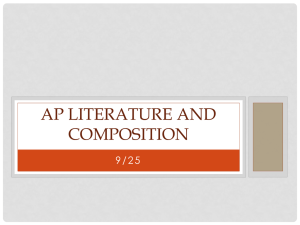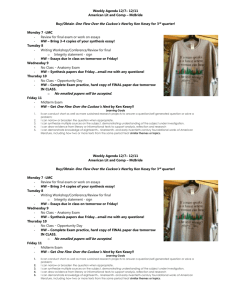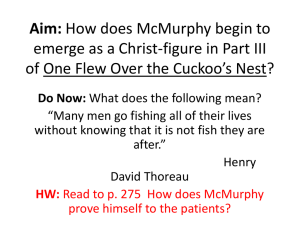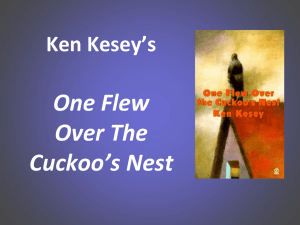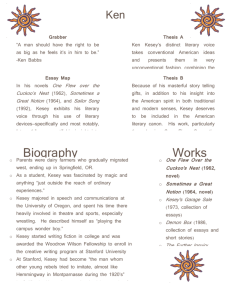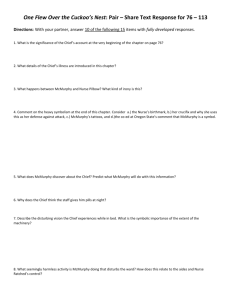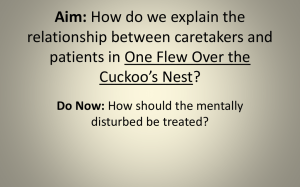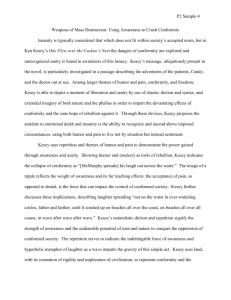OFOTNCPassage2_FL
advertisement
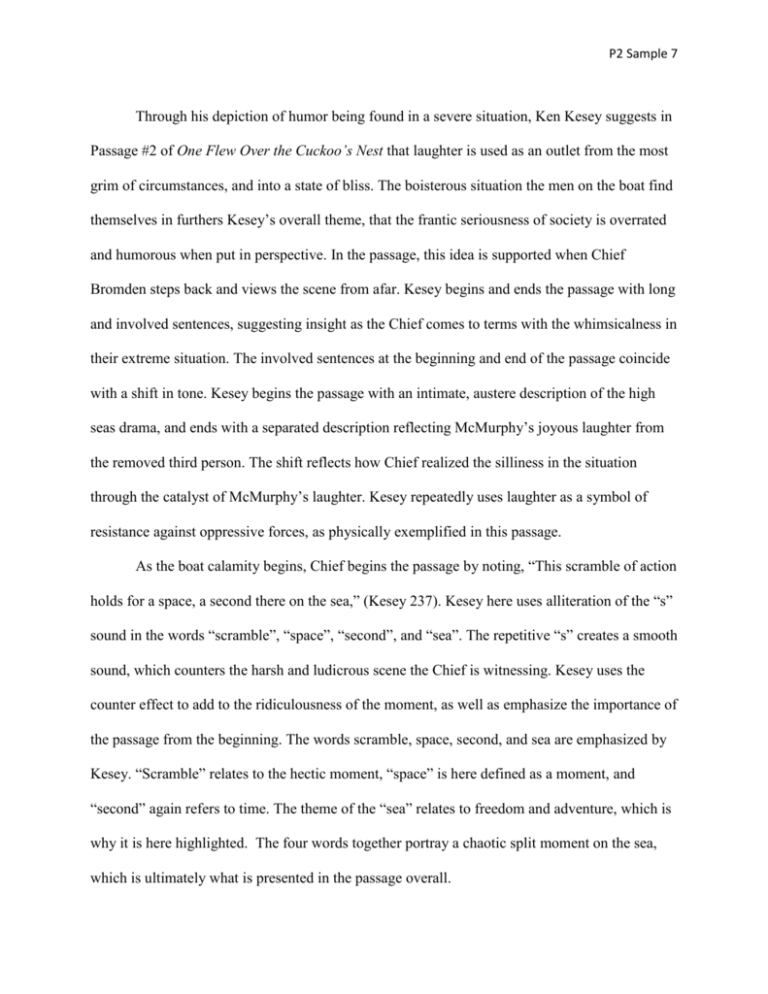
P2 Sample 7 Through his depiction of humor being found in a severe situation, Ken Kesey suggests in Passage #2 of One Flew Over the Cuckoo’s Nest that laughter is used as an outlet from the most grim of circumstances, and into a state of bliss. The boisterous situation the men on the boat find themselves in furthers Kesey’s overall theme, that the frantic seriousness of society is overrated and humorous when put in perspective. In the passage, this idea is supported when Chief Bromden steps back and views the scene from afar. Kesey begins and ends the passage with long and involved sentences, suggesting insight as the Chief comes to terms with the whimsicalness in their extreme situation. The involved sentences at the beginning and end of the passage coincide with a shift in tone. Kesey begins the passage with an intimate, austere description of the high seas drama, and ends with a separated description reflecting McMurphy’s joyous laughter from the removed third person. The shift reflects how Chief realized the silliness in the situation through the catalyst of McMurphy’s laughter. Kesey repeatedly uses laughter as a symbol of resistance against oppressive forces, as physically exemplified in this passage. As the boat calamity begins, Chief begins the passage by noting, “This scramble of action holds for a space, a second there on the sea,” (Kesey 237). Kesey here uses alliteration of the “s” sound in the words “scramble”, “space”, “second”, and “sea”. The repetitive “s” creates a smooth sound, which counters the harsh and ludicrous scene the Chief is witnessing. Kesey uses the counter effect to add to the ridiculousness of the moment, as well as emphasize the importance of the passage from the beginning. The words scramble, space, second, and sea are emphasized by Kesey. “Scramble” relates to the hectic moment, “space” is here defined as a moment, and “second” again refers to time. The theme of the “sea” relates to freedom and adventure, which is why it is here highlighted. The four words together portray a chaotic split moment on the sea, which is ultimately what is presented in the passage overall. P2 Sample 7 The first paragraph of Passage #2 is one long, intensive, and involved sentence. The sentence is used by Kesey to present the multitude of events simultaneously occurring, adding to the havoc and humor of the moment. By writing several actions that are all occurring in a list format, the uproarious scene is set: “The men yammering and struggling and cussing and trying to tend their poles while watching the girl; the bleeding, crashing battle…” (237). Kesey chooses verbs that relate to the intensity of the moment: yammering, struggling, cussing, trying, watching, bleeding, and crashing. It is necessary for Kesey to present all of these actions, and not just shorten the list, in order swell up the vehemence of the moment. All of the actions taking place, all in one sentence, create a hectic tone. This tone is next countered by McMurphy’s light and giddy laughter. After the disarray presented in the scramble on the sea, Kesey opposes the heavy intensity with the McMurphy’s whimsicality, in order to shift the tone. After a long and involved paragraph-long sentence, Kesey uses a telegraphic sentence to suggest the simplicity of McMurphy’s nature: “While McMurphy laughs,” (237). It is notable that McMurphy “laughs”, and the sentence is not presented as “McMurphy is laughing”, as all actions in the first paragraph are written. McMurphy’s simple present action, instead of present continuous, further separates him from the other men aboard the boat. Kesey uses the carefree laughter of McMurphy to immediately kill the harsh mood, causing all of the men to realize the silliness of their situation. A shift in point of view is next used by Kesey in order to gain the perspective of McMurphy, suggesting the true nature and motives behind his unprecedented laughter. From the first-person viewpoint of the Chief, a shift occurs to limited omniscient as McMurphy’s thoughts are revealed: “Because he knows you have to laugh at the things that hurt you just to keep yourself in balance, just to keep the world from running you plumb crazy. He knows there’s a P2 Sample 7 painful side; he knows my thumb smarts and his girl friend has a bruised breast and the doctor is losing his glasses, but he won’t let the pain blot out the humor no more’n he’ll let the humor blot out the pain,” (237). McMurphy’s insight contributes to his steadfast and worry-free nature, which is later seen as he puts the possibility of change in the Combine before his personal safety. The idea that laughter is used to keep one from going insane is presented here by McMurphy, which is notable because the Chief earlier mentions that McMurphy’s laugh is “The first laugh I’ve heard in years,” (11). Kesey suggests through McMurphy’s insight that the reason he has not yet been driven into the same state of insanity as the other men is because he maintains his ability to laugh. An epanalepsis is used at the end of McMurphy’s thoughts, as Kesey states, “he won’t let the pain blot out the humor no more’n he’ll let the humor blot out the pain”. The repetition of the phrase draws attention to the relationship between humor and pain, adding to the dark message that one cannot exist without the other. Through the enapalepsis, Kesey suggest that while neither humor nor pain are the cure for one another, they are necessary attributes to have in order to maintain sanity and make the best of the situation presented. The perspective shifts back to Chief Bromden’s, in order for Kesey to gain Bromden’s point of view as an outsider in the situation. The shift in point of view comes when Bromden states, “I notice Harding,” (237), instead of using third-person pronouns. Following this is a repetitive list of medium-length sentences, each beginning with the letter “a”: “And Scanlon from the bottom of the boat. At their own selves as well as at the rest of us. And the girl, with her eyes still smarting as she looks from her white breast to her red one, she starts laughing. And Sefelt and the doctor, and all,” (238). The repetition of the “a” sound adds to the flow of the list, supporting the infectious quality that McMurphy’s laugh presents. P2 Sample 7 Kesey utilizes the Chief as a distant viewer of the situation to suggest the ridiculousness of the scene from afar, as well as further secluding the Chief from the other men. As Chief Bromden states, “I watched, part of them, laughing with them—and somehow not with them,” (238), Kesey is suggesting that although he is physically a part of the group, mentally he is separated from the men as a distant outsider. This distance is shown as Bromden continues, “I was off the boat, blown up off the water and skating the wind with those black birds, high above myself, and I could look down and see myself, and the rest of the guys, see the boat rocking there in the middle of those diving birds, see McMurphy surrounded by his dozen people, and watch them, us, swinging a laughter that rang out on the water in ever-widening circles, farther and farther, until it crashed up on beaches all over the coast, on beaches all over all coasts, in wave after wave after wave,” (238). Bromden’s shifting perspective is again shown as he states, “…watch them, us”, adding to the idea that he is separated from the rest of the men. Kesey uses Bromden’s separation to suggest that while at sea, there is a much broader scope visible to the Chief for the first time, in contrast to the feeling of suffocation inside of the ward. As the Chief views the boat from an outsider’s perspective, the use of repetition and alliteration are used to emphasize the significance of the setting on a boat in the ocean. Alliteration of the “b” sound is used as Kesey states, “I was off the boat, blown up off the water and skating the wind with those black birds,” (238). The “b” makes a cold sound when attached to these one-syllable words. Kesey uses the alliteration to shift to a tone more harsh and bitter. The passage ends with the repeated use of repetition, further emphasizing the ending: “…farther and farther, until it crashed up on beaches all over the coast, on beaches all over all coasts, in wave after wave after wave,” (238). Kesey repeats the word “farther”, in order to emphasize the distance the ocean stretches. The repeated attention drawn to beaches on coasts also emphasizes P2 Sample 7 the significant size of the ocean, in parallel to the significant size of McMurphy’s laugh. Kesey chooses to end the passage with “wave after wave after wave”, in reference to the repeated and never-ending cycle of waves. Just as the waves continue to crash down without pausing, Kesey suggests that McMurphy’s attitude and laughter is continuous and unstoppable. Repetition, alliteration, and varied sentence length are key tools used by Kesey in depicting the rambunctious moment experienced by the men aboard the boat. By beginning and finishing with long and involved sentences, Kesey is able to fully view the setting from multiple perspectives. Through repetition, Kesey emphasizes the importance of the setting and the significance of the ocean. By alliterating sounds throughout the passage, shifts in the tone, from hectic to whimsical to insightful, can all be identified. Using these tools, Kesey suggests that comedy is necessary to survive without being sucked into insanity.
